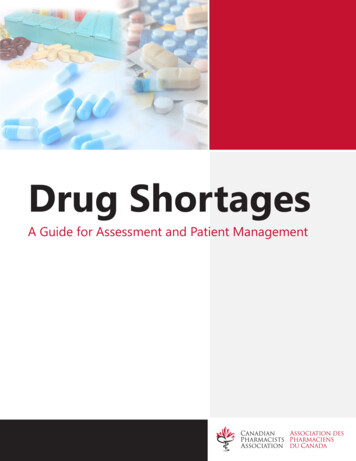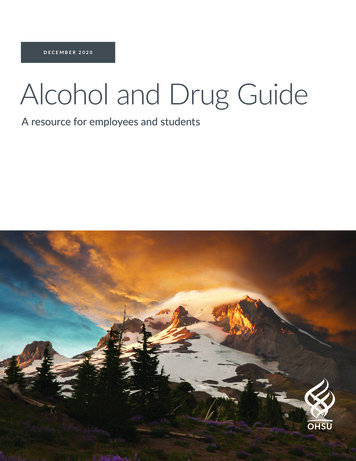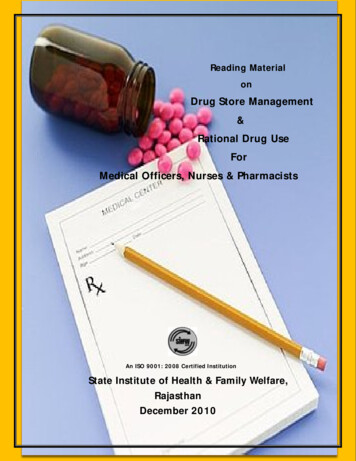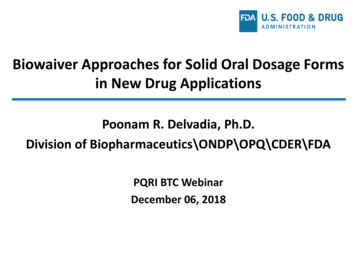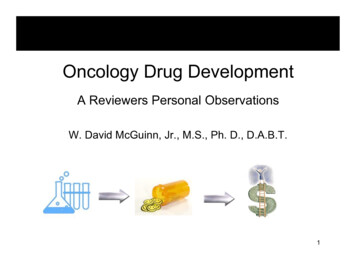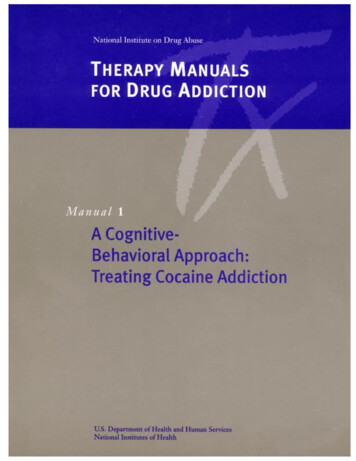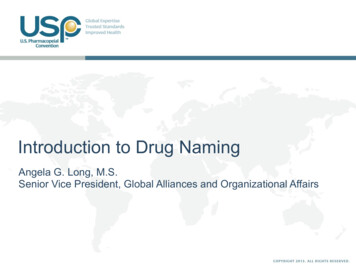
Transcription
2GLOBAL OVERVIEW OFDRUG DEMAND AND SUPPLY2019
United Nations, June 2019. All rights reserved worldwide.ISBN: 978-92-1-148314-7eISBN: 978-92-1-004174-4United Nations publication, Sales No. E.19.XI.8This publication may be reproduced in whole or in part and in any formfor educational or non-profit purposes without special permission fromthe copyright holder, provided acknowledgement of the source is made.The United Nations Office on Drugs and Crime (UNODC) would appreciatereceiving a copy of any publication that uses this publication as a source.Suggested citation:World Drug Report 2019 (United Nations publication, Sales No. E.19.XI.8).No use of this publication may be made for resale or any other commercialpurpose whatsoever without prior permission in writing from UNODC.Applications for such permission, with a statement of purpose and intent of thereproduction, should be addressed to the Research and Trend Analysis Branch of UNODC.DISCLAIMERThe content of this publication does not necessarily reflect the views orpolicies of UNODC or contributory organizations, nor does it imply any endorsement.Comments on the report are welcome and can be sent to:Division for Policy Analysis and Public AffairsUnited Nations Office on Drugs and CrimePO Box 5001400 ViennaAustriaTel: ( 43) 1 26060 0Fax: ( 43) 1 26060 5827E-mail: wdr@un.orgWebsite: www.unodc.org/wdr2019
PREFACEThe findings of this year’s World Drug Report fill inand further complicate the global picture of drugchallenges, underscoring the need for broader international cooperation to advance balanced andintegrated health and criminal justice responses todrug supply and demand.With improved research and more precise data fromIndia and Nigeria – both among the 10 most-populous countries in the world – we see that there aremany more opioid users and people with drug usedisorders than previously estimated. Globally, some35 million people, up from an earlier estimate of30.5 million, suffer from drug use disorders andrequire treatment services. The death toll is alsohigher: 585,000 people died as a result of drug usein 2017.Prevention and treatment continue to fall far shortof needs in many parts of the world. This is particularly true in prisons, where those incarcerated areespecially vulnerable to drug use and face higherrisks of HIV and hepatitis C transmission. This gaprepresents a major impediment to achieving the Sustainable Development Goals and fulfilling theinternational community’s pledge to leave no onebehind.Synthetic opioids continue to pose a serious threatto health, with overdose deaths rising in NorthAmerica and trafficking in fentanyl and its analoguesexpanding in Europe and elsewhere. The opioidcrisis that has featured in far fewer headlines butthat requires equally urgent international attentionis the non-medical use of the painkiller tramadol,particularly in Africa. The amount of tramadolseized globally reached a record 125 tons in 2017;the limited data available indicate that the tramadolbeing used for non-medical purposes in Africa isbeing illicitly manufactured in South Asia and trafficked to the region, as well as to parts of the MiddleEast.The response to the misuse of tramadol illustratesthe difficulties faced by countries in balancing necessary access for medical purposes while curbingabuse – with limited resources and health-care systems that are already struggling to cope – and at thesame time clamping down on organized crime andtrafficking.Opium production and cocaine manufacture remainat record levels. The amounts intercepted are alsohigher than ever, with the amount of cocaine seizedup 74 per cent over the past decade, compared witha 50 per cent rise in manufacture during the sameperiod. This suggests that law enforcement effortshave become more effective and that strengthenedinternational cooperation may be helping to increaseinterception rates.The World Drug Report 2019 also registers a declinein opiate trafficking from Afghanistan along the“northern” route through Central Asia to the Russian Federation. In 2008, some 10 per cent of themorphine and heroin intercepted globally was seizedin countries along the northern route; by 2017 ithad fallen to 1 per cent. This may be due in part toa shift in demand to synthetics in destination markets. The increased effectiveness of regional responsesmay also play a role.Countries in central Asia, with the support of theUnited Nations Office on Drugs and Crime(UNODC), have committed considerable resourcesto strengthening regional cooperation throughintegrated UNODC country, regional and globalprogrammes, as well as through platforms such asthe Central Asian Regional Information andCoordination Centre, the Afghanistan–Kyrgyzstan–Tajikistan Initiative and the Triangular Initiativeand its Joint Planning Cell. More research is needed,including to identify lessons learned and bestpractices that could inform further action.International cooperation has also succeeded inchecking the growth in new psychoactive substances.The Vienna-based Commission on Narcotic Drugshas acted swiftly in recent years to schedule the mostharmful new psychoactive substances, and theUNODC early warning advisory has helped to keepthe international community abreast ofdevelopments.Political will and adequate funding remain prerequisites for success. Efforts by Colombia to reducecocaine production following the 2016 peace deal1
WORLD DRUG REPORT 2019GLOBAL OVERVIEW OF DRUG DEMAND AND SUPPLYwith the Revolutionary Armed Forces of Colombia(FARC) are a case in point. Alternative developmentinitiatives have enabled farmers in central areas ofthe country previously under FARC control to abandon coca bush cultivation and join the licit economy.The result has been a drastic reduction in cocaineproduction. However, in other areas previously controlled by FARC, criminal groups have moved in tofill the vacuum and expand cultivation. Alternativedevelopment can succeed, but not without sustainedattention and integration into broader developmentgoals.The successes identified amid the many, formidableproblems that countries continue to face in grappling with drug supply and demand highlight thatinternational cooperation works. The challengebefore us is to make this cooperation work for morepeople.International cooperation is based on agreed frameworks. Nearly every country in the world hasreaffirmed its commitment to balanced, rights-basedaction based on the international drug control conventions. The most recent reaffirmation of thatcommitment is the Ministerial Declaration onStrengthening Our Actions at the National, Regionaland International Levels to Accelerate the Implementation of Our Joint Commitments to Addressand Counter the World Drug Problem, adopted atthe ministerial segment of the sixty-second sessionof the Commission on Narcotic Drugs.2UNODC supports countries in putting their commitments into action through the application ofinternational standards on the prevention and treatment of drug use disorders and HIV, as well asstandards and norms on the administration of justiceand the treatment of prisoners. We provide tailoredtechnical assistance through our field offices andglobal programmes, and through toolkits andresearch.I hope the World Drug Report 2019 will shed furtherlight on the world drug problem and inform international community responses. By working togetherand focusing attention and resources, we can helppeople get the services they need without discrimination, promote security and bring criminals tojustice, safeguard health and achieve the SustainableDevelopment Goals.Yury FedotovExecutive DirectorUnited Nations Office on Drugs and Crime
CONTENTSBOOKLET 1EXECUTIVE SUMMARY, CONCLUSIONS AND POLICY IMPLICATIONSBOOKLET 2GLOBAL OVERVIEW OF DRUG DEMAND AND SUPPLYPREFACE. 1EXPLANATORY NOTES. 5SCOPE OF THE BOOKLET. 7DRUG DEMAND. 9Extent of drug use . 10Health consequences of drug use . 19Drug use, infectious diseases and the provision of prevention andtreatment services in prison settings. 32DRUG SUPPLY. 43ANNEX. 59GLOSSARY. 75REGIONAL GROUPINGS. 77BOOKLET 3DEPRESSANTSBOOKLET 4STIMULANTSBOOKLET 5CANNABIS AND HALLUCINOGENS3
AcknowledgementsThe World Drug Report 2019 was prepared by the Research and Trend Analysis Branch, Division forPolicy Analysis and Public Affairs, United Nations Office on Drugs and Crime (UNODC), under thesupervision of Jean-Luc Lemahieu, Director of the Division, and Angela Me, Chief of the Research andTrend Analysis Branch.General coordination and content overviewChloé CarpentierAngela MeAnalysis and draftingPhilip DavisThomas PietschmannData management and estimate productionEnrico BisognoConor CreanHernan EpsteinVirginia Macdonald (WHO)Riku LehtovuoriSabrina LevissianosAndrea OterováUmidjon RakhmonberdievAli SaadeddinTun Nay SoeKeith Sabin (UNAIDS)Fatma UshevaEditingJonathan GibbonsGraphic design and productionAnja KorenblikSuzanne KunnenKristina KuttnigFabian RettenbacherCoordinationFrancesca MassanelloAdministrative supportIulia LazarReview and commentsThe World Drug Report 2019 benefited from the expertise of and invaluable contributions fromUNODC colleagues in all divisions.The Research and Trend Analysis Branch acknowledges the invaluable contributions and adviceprovided by the World Drug Report Scientific Advisory Committee:Jonathan CaulkinsAfarin Rahimi-MovagharPaul GriffithsPeter ReuterMarya HynesAlison RitterVicknasingam B. KasinatherFrancisco ThoumiCharles ParryThe research and production of the joint UNODC/UNAIDS/WHO/World Bank estimates ofthe number of people who inject drugs were partly funded by the HIV/AIDS Section of the DrugPrevention and Health Branch of the Division for Operations of UNODC.
EXPLANATORY NOTESThe boundaries and names shown and the designations used on maps do not imply official endorsementor acceptance by the United Nations. A dotted linerepresents approximately the line of control inJammu and Kashmir agreed upon by India and Pakistan. The final status of Jammu and Kashmir hasnot yet been agreed upon by the parties. Disputedboundaries (China/India) are represented by crosshatch owing to the difficulty of showing sufficientdetail.The designations employed and the presentation ofthe material in the World Drug Report do not implythe expression of any opinion whatsoever on thepart of the Secretariat of the United Nations concerning the legal status of any country, territory, cityor area, or of its authorities or concerning the delimitation of its frontiers or boundaries.Countries and areas are referred to by the namesthat were in official use at the time the relevant datawere collected.All references to Kosovo in the World Drug Report,if any, should be understood to be in compliancewith Security Council resolution 1244 (1999).Since there is some scientific and legal ambiguityabout the distinctions between “drug use”, “drugmisuse” and “drug abuse”, the neutral term “druguse” is used in the World Drug Report. The term“misuse” is used only to denote the non-medical useof prescription drugs.All uses of the word “drug” and the term “drug use”in the World Drug Report refer to substances controlled under the international drug controlconventions, and their non-medical use.The data on population used in the World DrugReport are taken from: World Population Prospects:The 2017 Revision (United Nations, Department ofEconomic and Social Affairs, Population Division).References to dollars ( ) are to United States dollars,unless otherwise stated.References to tons are to metric tons, unless otherwise stated.The following abbreviations have been used in thepresent booklet:AIDS acquired immunodeficiencysyndromeATS amphetamine-type stimulantsDALY disability-adjusted life yearEMCDDA European Monitoring Centre forDrugs and Drug AddictionEuropol European Union Agency for LawEnforcement CooperationGBL gamma-butyrolactoneGHB gamma-hydroxybutyric acidHIV human immunodeficiency virusLSD lysergic acid diethylamideNPS new psychoactive substancesPWID people who inject drugsUNAIDS Joint United Nations Programmeon HIV/AIDSUNODC United Office on Drugs and CrimeWHO World Health OrganizationAll analysis contained in the World Drug Report isbased on the official data submitted by MemberStates to the UNODC through the annual reportquestionnaire unless indicated otherwise.5
SCOPE OF THE BOOKLETThis booklet constitutes the second chapter of theWorld Drug Report 2019. It provides a global overview of the extent of and trends in drug use,including drug use disorders, and its health consequences, and examines the global extent of deathsand years of “healthy” life lost attributable to druguse. The present booklet also examines drug use,infectious diseases and the provision of preventionand treatment services in prison settings. The finalsection of the booklet contains a global overview ofthe latest estimates of and trends in drug cultivation,production and trafficking of drugs, including onthe Internet via the darknet.Use of any drugsduring incarceration31%at least once19%past monthNumber of past-year users in hetamines andprescription stimulants“ecstasy”cocaine7
Extent of drug useFig. 1Extent of drug use400More than a quarter of a billion peopleuse drugsMillions1000Number of people who use drugsNumber of people with drug use disordersSource: UNODC, responses to the annual report questionnaire.Note: Estimates of people who use drugs are for adults (aged15–64) who used drugs in the past year.Fig. 2Over the last decade, there has been a diversificationof the substances available on the drug markets. Inaddition to traditional plant-based substances – cannabis, cocaine and heroin – the last decade haswitnessed the expansion of a dynamic market forsynthetic drugs and the non-medical use of prescription medicines. More potent drugs are available andthe increasing number of substances, and theirpotential combinations, poses a greater risk.In recent years, hundreds of NPS have been synthesized. The majority are stimulants, followed bycannabinoids and an increasing number of opioids,with unpredictable and sometimes severe negativeconsequences, including death. The non-medicaluse of pharmaceutical opioids is of increasing concern. In North America, the use of synthetic opioidssuch as fentanyl (and fentanyl analogues) resultedin the continued dramatic increase in opioid overdose deaths in 2017. In other subregions, such asWest and Central Africa and North Africa, basedon seizures, the market for the non-medical use oftramadol has grown considerably. The 0162017In 2009, the past-year prevalence of drug use globally was estimated to be lower, at 4.8 per cent.Between 2009 and 2017, the estimated number ofpast-year users of any drug globally changed from210 million to 271 million, or by 30 per cent, inpart as a result of global population growth (theglobal population aged 15–64 increased by 10 percent). Data show a higher prevalence over time ofthe use of opioids in Africa, Asia, Europe and NorthAmerica, and in the use of cannabis in North America, South America and Asia. It should be noted,however, that any comparison of estimates over timeshould be undertaken with caution, given the wideuncertainty intervals of the estimates.300Annual prevalence (percentage)In 2017, an estimated 271 million people worldwideaged 15–64 had used drugs at least once in the previous year (range: 201 million to 341 million). Thiscorresponds to 5.5 per cent of the global populationaged 15–64 (range: 4.1 to 6.9 per cent), representing one in every 18 people.Global trends in the estimated numberof people who use drugs and thosewith drug use disorders, 2006–2017Global trends in the estimatedprevalence of drug use and drug usedisorders, 14201520162017DRUG DEMAND2Prevalence of people who use drugsPrevalence of people with drug use disordersSource: UNODC, responses to the annual report questionnaire.Note: Estimated percentage of the annual prevalence of drug useis for adults (aged 15–64) who used drugs in the past year.large-scale national drug use survey conducted inNigeria, in 2017, found a high prevalence of thenon-medical use of prescription opioids (mainlytramadol), which was second only to the use of cannabis, with a past-year prevalence of 4.7 per cent.11UNODC, Drug Use in Nigeria 2018 (Vienna, 2019).9
WORLD DRUG REPORT 2019GLOBAL OVERVIEW OF DRUG DEMAND AND SUPPLYRecent drug use surveys in Nigeria and India: enhancingunderstanding of the extent of drug use in Africa and Asia andgloballyNational drug use surveys that were conducted in India in 2018a and Nigeria in 2017b have considerably improvedunderstanding of the extent of drug use in these two highly populated countries. Because of their large populations,Nigeria and India exert a considerable influence over regional, as well as global, estimates of drug use. Nigeria isthe most populous country in Africa, accounting for 38 per cent of the population aged 15‒64 in West and CentralAfrica and 15 per cent of the population of Africa as a whole, while 86 per cent of the population in South Asiaand 30 per cent of the population in Asia reside in India.Percentage changeSurvey findings from India have revealed a higher prevalence of the use of opioids and opiates in Asia than previously estimated for the region. At 1.0 per cent, the past-year prevalence of the use of opioids in Asia was higher in2017 than in 2016, when it was 0.5 per cent, representingImpact of new survey findings from India and a change of 117 per cent in the number of past-year usersNigeria on global estimates of thefrom 13.6 million to 29.5 million. While, at 0.7 per cent,number of past-year users, by drug type, andthe prevalence of the use of opiates in Asia was also estipeople who inject drugsmated to be higher in 2017 than in 2016, when it was 0.460per cent, corresponding to a change in the number ofIndiapast-year users from 11.2 million to 21.7 million. Like50wise, in Africa, the past-year prevalence of the use of40opioids was estimated to be higher in 2017 (0.9 per cent)30than in 2016 (0.3 per cent), corresponding to a change in20the number of past-year users from 2.2 million to 6.1million, or of 178 per cent. The updated global estimates10of the use of opioids and opiates reflect new information0from five countries, but the main changes from previous-10global estimates result from the new surveys conducted inNigeria and India.-2060Percentage change50Nigeria403020100-10People who inject minesDrug use disordersAny drug-20Note: The bars show the percentage change in the 2017 global estimates of past-year drug users compared with what the 2017 globalestimates would have been had the surveys not been conducted.10Conversely, survey findings from India and Nigeria haveled to lower regional estimates of the use of amphetamines in Africa and Asia, as well as globally. In Africa, thepast-year prevalence was estimated to be lower in 2017(0.5 per cent) than in 2016 (0.9 per cent), resulting infewer past-year users in 2017 (3.7 million) than in 2016(6.0 million), while in Asia the prevalence was estimatedat 0.5 per cent in 2017 and 0.6 per cent in 2016, a changein the number of past-year users from 17.5 million in2016 to 14.1 million in 2017. As for opioids and opiates,while updated information on the use of amphetamineswas available for five countries, most of the change in theglobal estimates are the result of the surveys conducted inNigeria and India.Estimates for the past-year prevalence of cocaine use werealso lower in Africa in 2017 (0.2 per cent) than in 2016(0.5 per cent), with correspondingly fewer past-year usersestimated in 2017 (1.3 million) compared with 2016 (3.2million). Nigeria was the only country in Africa with newor updated information on the prevalence of the use ofcocaine.
Extent of drug use2Prior to these surveys, there were no recent survey data available for Nigeria or India on the past-year prevalence ofdrug use and regional estimates for Africa and Asia were constructed on the basis of data available from othercountries in those regions.The survey conducted in India in 2018 involved interviews with more than 500,000 individuals across all 36 statesand territories. A combination of two data collection approaches was employed: a household survey among anationally representative sample of 473,569 individuals aged 10‒75; and a respondent-driven sampling survey of72,642 people with drug dependence, incorporating treatment multiplier methods. The survey also estimated thenumber of PWID as 850,000, which compares to a previous estimate of 177,000 in 2008 by the National AIDSControl Organization, based on mapping conducted in urbanized areas in 17 states.The first comprehensive nationwide drug use survey conducted in Nigeria, in 2017, employed both a householdsurvey of 38,850 respondents, incorporating network scale-up methods, and a high-risk drug user survey of 9,344problem drug users using respondent-driven sampling and multiplier benchmark methods. The results of the surveyhighlighted a considerable level of past-year use of psychoactive substances. Cannabis was the most commonly usedrug followed by opioids, mainly the non-medical use of prescription opioids (predominantly tramadol). Thesurvey placed Nigeria among the countries with the highest prevalence of the non-medical use of opioids globally.These two recent surveys, of high scientific quality, have led to major improvements in the data coverage of thepopulations in their respective regions. The new survey in India (in particular) and Nigeria have had a considerableinfluence on estimates of the extent of drug use globally. The impact is seen especially for opioids and opiates, whichhave also influenced global estimates of the number of people suffering from drug use disorders. New data fromIndia has also impacted on global estimates of PWID.a Atul Ambekar and others, Magnitude of Substance Use in India 2019 (New Delhi, Ministry of Social Justice and Empowerment, 2019.b United Nations Office on Drugs and Crime (UNODC) and government of Nigeria, Drug Use in Nigeria 2018 (Vienna, 2019).Some 35 million people suffer fromdrug use disordersAmong the estimated 271 million past-year usersof any drug, some 35.0 million (range: 23.0 millionto 47.0 million), or almost 13 per cent, are estimatedto suffer from drug use disorders, meaning that theirdrug use is harmful to the point where they mayexperience drug dependence and/or require treatment. This corresponds to a prevalence of drug usedisorders of 0.71 per cent (range: 0.47 to 0.95 percent) globally among the population aged 15–64.Between 2009 and 2016, the prevalence of drug usedisorders remained essentially stable globally, withthe number of people suffering from drug usedisorders changing over that period in line withpopulation growth. However, in 2017, theprevalence of drug use disorders (0.71 per cent) washigher than previously estimated (0.62 per cent in2016), corresponding to a change in the estimatednumber of people suffering from drug use disordersfrom 30.5 million to 35.0 million. This higherprevalence is the result of the findings of drug usesurveys conducted recently in two highly populatedcountries, Nigeria and India (see box). Given thewide uncertainty intervals of the estimates,comparisons over time should be undertaken withcaution.Cannabis remains by far the mostcommonly used drugWorldwide, there were an estimated 188 million pastyear users of cannabis in 2017, corresponding to 3.8per cent of the global population aged 15–64. Theannual prevalence of the use of cannabis is highestin North America (13.8 per cent), Oceania (10.9 percent) and West and Central Africa (10.0 per cent).11
WORLD DRUG REPORT 2019GLOBAL OVERVIEW OF DRUG DEMAND AND SUPPLYIn 2010, cannabis use, particularly among youngpeople, was reported as stabilizing or declining incountries with established cannabis markets, suchas in Western and Central Europe, North Americaand parts of Oceania (Australia and New Zealand),but that trend was offset by increasing consumptionin many countries in Africa and Asia. While cannabis use in Western and Central Europe is stillreported as stabilizing, it has increased considerablyin the Americas, Africa and Asia.opioids in Western and Central Europe, as reflectedin the increasing proportion of admissions to treatment for the use of those substances.Opioids present the greatest harmto the health of usersAmong users of opioids, 29.2 million were past-yearusers of opiates (heroin and opium) in 2017, corresponding to 0.6 per cent of the global populationaged 15–64; the number of past-year users of opiates globally is 50 per cent higher than the previouslyestimated 19.4 million in 2016 (the result of animprovement in the understanding of the extent ofthe use of opiates based on recent survey findingsfrom India and Nigeria). The subregions with thehighest prevalence of use of opiates are the Near andMiddle East and South-West Asia (1.6 per cent),South Asia (1.3 per cent) and Central Asia and Transcaucasia (0.9 per cent).Opioids are a major concern in many countriesbecause of the severe health consequences associatedwith their use. For example, in 2017, the use ofopioids accounted for 110,000 (66 per cent) of the167,000 deaths attributed to drug use disorders.2The opioid crisis continues in North America, reaching new highs in the number of opioid overdosedeaths in the United States of America and Canada,with the increases largely attributed to the use offentanyl and its analogues.There were an estimated 53.4 million past-year usersof opioids (both persons who use opiates and persons who use prescription opioids for non-medicalpurposes) globally in 2017. This corresponds to 1.1per cent of the global population aged 15–64. Thenumber of past-year users of opioids globally is 56per cent higher than the previously estimated 34.3million in 2016. The change is the result of animprovement in the understanding of the extent ofdrug use based on recent surveys conducted in Nigeria and India (see the box on the previous page).The subregions with the highest past-year prevalenceof use of opioids were North America (4.0 per cent),Oceania (3.3 per cent for Australia and New Zealand), the Near and Middle East and South-WestAsia (2.3 per cent) and South Asia (1.8 per cent).While global estimates are not available, the nonmedical use of pharmaceutical opioids is reportedin many countries, for example, in West and NorthAfrica and in the Near and Middle East (tramadol),and in North America (hydrocodone, oxycodone,codeine, tramadol and fentanyl). There are also signsof increasing non-medical use of pharmaceutical212Institute for Health Metrics and Evaluation, “Global Burdenof Disease Study 2017”, Global Health Data Exchange.The results of the first large-scale nationwide druguse survey conducted in Nigeria in 2017, the mostpopulated country in Africa, highlighted aconsiderable level of past-year non-medical use ofprescription opioids (mainly tramadol), with anannual prevalence of 6.0 per cent among men and3.3 per cent among women.3Use of amphetamines, especially methamphetamine, is increasing in parts ofAsia and North AmericaIn 2017, there were an estimated 28.9 million pastyear users of amphetamines, corresponding to 0.6per cent of the global population aged 15–64, 15per cent lower than the previously estimated 34.2million in 2016 (the result of an improvement inthe understanding of the use of amphetamines basedon recent survey findings from Nigeria and India).The highest past-year prevalence among the population aged 15–64 was in North America (2.1 percent) and Oceania (1.3 per cent).The form of amphetamines used varies considerablyfrom region to region. In North America, it is mainlythe non-medical use of prescription stimulants andmethamphetamine; crystalline methamphetaminein East and South-East Asia and Oceania (Australia);and amphetamine in Western and Central Europeand the Near and Middle East. Since 2010, therehas been a relatively stable situation in use ofamphetamines in most countries in Western and3Drug Use in Nigeria 2018.
Extent of drug useCentral Europe, although data based on the analysisof wastewater have shown an increase in recent years.In North America, there are indications of anincrease in methamphetamine use, while the use ofmethamphetamine, in particular crystalline methamphetamine, has continued to be reported asincreasing in East and South-East AsiaPast-year use of “ecstasy” is estimated at 21.3 million people globally, corresponding to 0.4 per centof the global population aged 15–64. Past-year useof “ecstasy” is rel
about the distinctions between "drug use", "drug misuse" and "drug abuse", the neutral term "drug use" is used in the World Drug Report. The term "misuse" is used only to denote the non-medical use of prescription drugs. All uses of the word "drug" and the term "drug use" in the World Drug Report refer to substances con-



